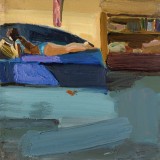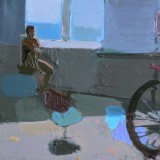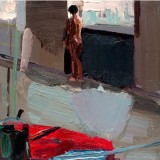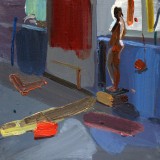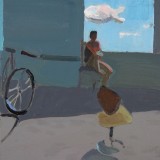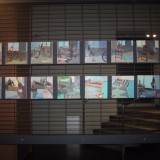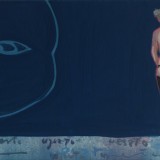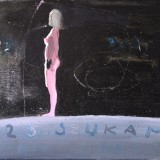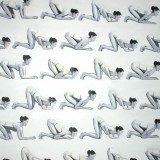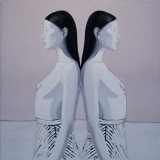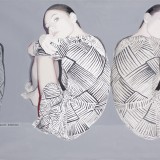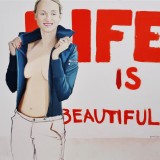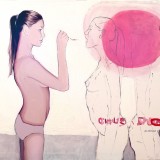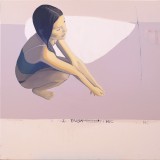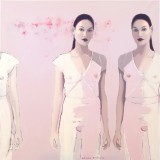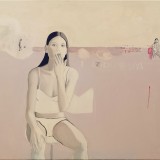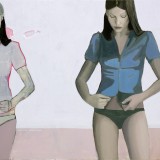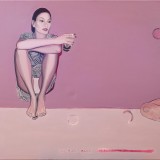Agnieszka Borkowska
Agnieszka Borkowska She graduated from the Department of Visual Education (now the Department of Visual Arts) within the Academy of Fine Arts in Łódź. She has participated in more than 30 group exhibitions and a few solo shows in Poland and abroad. Together with an Auction House – “Art Market” she organises and conducts the promotional biddings for the Academy of Fine Arts graduates. Since 2008 she has co-operated with the Sandhofer Gallery in Insbruck. The artist’s works are in private galleries in Poland, Germany, France, Holland and England. In 2005 Borkowska was in the finals of the “Painting of the Year” competition.
Agnieszka Borkowska as opposed to many other young artists, is focused on the one medium – painting and on one motif – a woman. Her first works, which were created while she was still a student, were small canvas, measuring 20x20 cm and the artist presented them in a series of a dozen or so paintings. Works arranged this way could be seen during her first solo show in the Opus Gallery in Łódź, which was accompanied by a catalogue. The paintings are impasted, painted with a gesture, in which from aptly put colour stains emerges an interior and a female’s silhouette within it. It is easy to associate these paintings with the intimitism of the paintings by Bonnard and Vuillard. Unclothed women on the paintings are absolutely unconcerned about the presence of the viewer, they simply sit, look through the window, occupy themselves. The figures are often painted against the background of a window, so they are hidden in a shadow. While looking at Borkowska’s paintings one may get the impression that we are watching women through a keyhole, from a distance. In her later works the artist eliminated elements of the background and limited it to 2-3 colour patches, thus making the viewer focus on the figure itself. The works are still created in an intimate atmosphere. There is an erotic element to them – the women are not always completely naked and sometimes wear garters or other underwear. The works are still painted in a sketchy way and have a variety of texture. The artist discretely ads handwritten notes, not always legible, as if they were notes on some interrupted thoughts, the mental state of one moment.
Around 2009 we can observe a change in the way she paints. The canvases are larger, the artist shortened the distance between the figure and the viewer and the silhouettes take a larger part of the painting. Despite the synthetic way of painting, she started to pay more attention to details. She works more on the faces, on which we can see make-up, she pays attention to hands with nail polish, highlights a pattern on a dress. She gets closer in style to pop culture aesthetics. On a canvas from 2009 we see the multiplied figure of a woman who kneels and licks the floor. Her movement is shown in two sequences and in this way there is a rhythm and dynamics in the painting. Multiplication is associated also with the works by Andy Warhol. On another work we can see a couple of teenagers, a sketch of a male silhouette turned around from the viewer and looking into the distance and a girl with a red lollipop in her mouth looking courageously into the direction of the viewers as if she was waiting for something. Here detailed parts of the painting are contrasted with an illustrative, sketchy, contour approach, which the artist uses often. The paintings are also painted more smoothly and subtly.
In the paintings the figures are very similar to each other, but usually they are not in a relationship – they are turned away from each other or busy occupying themselves for example getting dressed. The action of dressing or undressing is one of the motifs that often appears in the paintings by Agnieszka Borkowska. One never knows which of these two actions the women perform. The artist also fades the colours – grey, blue, toned down pink or yellow dominate. Sometimes there is one strong element, such as a bright red text: „life is beautiful” which appeared behind a figure smiling in the foreground. We can feel a certain irony, an artificial smile which brings associations with the faces of celebrities from tabloids.
It is also worth noticing the non-typical composition of Borkowska’s paintings –fragments cut off by the frame. Next to two figures that we can see on the painting, we can see a fragment of the third one, pushed to the peripherals of it. Why didn’t it fit in the frame? Or maybe the artist didn’t want to show it…
While looking at Agnieszka’s paintings we feel some kind of strangeness and anxiety. The artist balances on extreme painting styles – next to realistic fragments we have parts which are treated very briefly. Abstract colourful planes are contrasted with a precise stroke. Women with bodies modelled with a subtle chiaroscuro are confronted with their ephemeral, non-carnal alter ego.
In her first paintings the artist was interested in the motif of a figure inside of an interior – a room. In her recent works we can rather talk about the notions of an interior and exterior in the sense of the relationship between the image presented on the outside and the world of a female psyche.
Anka Leśniak


